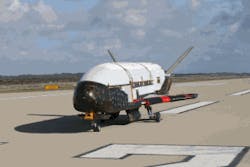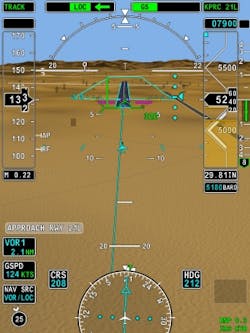Synthetic vision: operational credit approaches
Part one of a two part story by Charlotte AdamsGood news is on the way for early adopters of synthetic vision system (SVS) cockpit technology in search of operational credit. This GPS-based, computer-generated picture of terrain and obstacles from the pilot's viewpoint enhances situational awareness, increases performance and decreases workload in the cockpit, but currently offers no operational credit. Business jet operators are adopting the technology, but penny-pinching airlines are unlikely to demand it until synthetic vision achieves this milestone.A meeting of the Radio Technical Commission for Aeronautics (RTCA) Special Committee 213 (SC-213) and EUROCAE's Working Group 79 in Phoenix last month, however, took giant steps toward defining performance standards for a new "SV-150" straight-in approach concept that would use synthetic vision and instrument landing system (ILS) technology. SV-150 could potentially achieve a lower decision height (DH) than a conventional Category I (CAT I) ILS approach without SVS-150 feet vs. 200 feet. Synthetic vision would be used to improve the pilot's visual search for the runway as the aircraft nears the DH. The pieces necessary to approve and then fly the approach could be in place as early as next year.Airframer flightsBombardier hopes to be first airframer to enable its customers to take advantage of synthetic vision operational credit, as soon as it is granted by the Federal Aviation Administration (FAA). The company expects to certify its Global Vision flight deck on the Global Express and Global 5000 this year, including the head-up display (HUD), the synthetic vision presentation on the HUD, enhanced flight vision system (EFVS) on the HUD and synthetic vision on the primary flight display (PFD). The cockpit uses Rockwell Collins' new Pro Line Fusion avionics. The Rockwell Collins design permits the pilot to select either synthetic vision or infrared-based enhanced vision system (EVS) on the HUD, allowing a seamless, head-up transition from synthetic to natural vision via the sensor or the naked eye.Bombardier pilots are already flying synthetic vision/ILS approaches, as part of the company's experimental and flight test programs, says Capt. Mark Schlegel, Bombardier's senior engineering test pilot at the company's Flight Test Center in Wichita, Kan. They have not flown these approaches in weather yet, but "it's on our test calendar," he adds. Honeywell and Gulfstream, meanwhile, under a recent NASA contract, will be conducting synthetic vision and enhanced vision research flights. The $1.2-million, 11-month program will explore the use of "visual flight rules-like" procedures in instrument conditions, according to the Honeywell announcement. Gulfstream is using its G450 experimental aircraft, equipped with the certified Honeywell SmartView head-down synthetic vision and a certified EFVS -- a Rockwell Collins HUD with Kollsman enhanced vision system. Testing will involve two components: synthetic vision-only with DH down to 150 feet and runway visual range (RVR) down to 1,400 feet and; and EFVS to the ground (with safety mitigations) and RVR of 1,000 feet.
Honeywell has also been showcasing its as-yet-uncertified "merging" of enhanced vision and synthetic vision images on the PFD. The goal is to present to the pilot the best possible picture of the outside world at any time and regardless of the infrared camera's ability to see through weather conditions. It's more image fusion than sensor fusion, says Chad Cundiff, vice president of crew interface products at Honeywell. The avionics system decides which enhanced vision and synthetic vision elements to combine, based on a set of rules, so that the pilot gets the "best of both worlds." FAA approval could come as soon as 2013. Honeywell is aiming its "combined vision system" at both business and commercial aviation. Where industry -- especially commercial aviation -- is going to want credit is at mid-sized fields, Cundiff says. Very large fields have autoland systems, but smaller fields such as San Diego or Midway do not. Technologies that permit pilots to see the runway sooner and continue on visually, could potentially allow them to land where the weather is below minimums.SV-150: how to get there?Much remains to be done, stresses Tim Etherington of Rockwell Collins, a co-chair of SC-213. RTCA has to approve and publish the committee's final product, a document called DO-315B -- now in draft form -- which describes the SV-150 approach concept, necessary equipage and required performance, among other things.Some industry observers expect that the FAA, rather than undertake an synthetic vision rulemaking, will modify its Order 8400.13D to incorporate synthetic vision-with-ILS operations, so that the aircraft manufacturers can get operational approval to fly the approach. The agency uses 8400.13 to allow operational credit to a lower DH and/or reduced visibility minimums for certain ILS approach procedures at facilities whose ILS infrastructures meet integrity, obstacle-protection, and other criteria -- and have been flight-checked by the FAA. (Order 8400.13D describes the requirements for lower-minimum, "special authorization" CAT I approaches -- what SV-150 aspires to be.)The FAA's certification arm would also have to agree that an applicant's avionics, using synthetic vision for lower minimums, meet the requirements for such approaches. "Any future FAA guidance would be published to enable installation and operations," the agency says.SV-150SV-150 is conceived as a special authorization CAT I approach with a DH of 150 feet and RVR potentially down to 1,400 feet. A standard CAT I approach, by contrast, involves a decision height of 200 feet and RVR of 2,400 feet, depending on the ground infrastructure, although 1,800 RVR with a HUD or flight director is approved at some airports, RTCA's Etherington explains. The FAA is not officially considering SV-150 at this time because it is just a concept whose features and architecture are "somewhat hypothetical at the moment," says Les Smith, manager of the agency's Flight Technology and Procedures Division in the Flight Standards Service. He agrees that there could be a way -- using FAA Order 8400.13 -- to get some credit for synthetic vision on an ILS approach, although 8400.13 could only be used for an ILS approach. At the moment, however, the agency does not have an applicant for the approach. Baby step for synthetic visionRTCA's Etherington describes SV-150 as a "first concept," to get people comfortable with synthetic vision and ease its introduction for operational credit. He envisions employing an ILS that has been flight-checked and is usable at least to the runway threshold, which includes the majority of ILS facilities in the U.S.SV-150 would use ILS as its primary navigation source and "augmented GPS" as a secondary "precision positioning source" to position the synthetic vision imagery. "Augmentation" probably will mean the use of Wide Area Augmentation System (WAAS) GPS, but the final interpretation was still under debate late last month. While ILS gives the pilot near-certainty of obstacle protection within the approach path, the new procedure is also likely to increase confidence in the use of synthetic vision as a means of reducing the flight crew component of flight technical error (FTE) and aid in transitioning from the instrument to the visual segment of the approach. This would pave the way toward the development of an approach procedure using synthetic vision with WAAS GPS, but without ILS.In the SV-150 approach the synthetic vision display would be "used so the pilot can understand all the dynamics and know where to look for the runway when the aircraft nears the [150-foot] decision height," Etherington explains. When the pilot looks up from the runway depiction on the synthetic vision display, he should see the real runway in the same place. As the FAA's Smith points out, however, synthetic vision in this case would nevertheless be a "supplementary system," not a means of navigation. The use of ILS, a precision landing technology that is completely independent from GPS, is appropriate for synthetic vision's first step toward operational credit. ILS solves the issue of knowing where the obstacles and terrain are with a high degree of accuracy and integrity. Since synthetic vision is dependent on GPS, and GPS has positional errors and time-to-warn issues, SV-150 uses ILS as a boundary, a means of setting limits on, the overall system error, including the flight technical error of the pilot. The crosschecking of ILS and GPS make the synthetic vision/GPS approach potentially safer to fly than a comparable ILS or GPS approach, alone.Among the avionics capabilities identified so far for SV-150 are synthetic vision (with an accurate depiction of the intended destination runway and error alerting), ILS receiver and display, FTE alerting, high-integrity terrain/obstacle/runway databases, radar altimeter, and a PFD or HUD with flight path vector, flight path angle reference cue and acceleration chevron. SC-213 at this time is allowing for a PFD or a HUD -- it is not yet clear whether a HUD will be mandatory. This equipage list, however, is subject to change.ILS decouplingSome members of SC-213 are also eager to develop performance standards for a WAAS LPV-with- synthetic vision approach that would permit lower minimums than this GPS-based laterally and vertically guided approach would normally allow. LPV, a WAAS approach known as localizer performance with vertical guidance, provides minimums as low as 200 feet with one-half mile visibility. Supporters of an LPV/synthetic vision approach hope to cut the decision altitude (DA) to 150 feet. This will be a harder nut to crack, however, since both LPV and synthetic vision rely on the GPS signal. "Right now there is no redundancy in that sort of design regime," says the FAA's Smith. While WAAS brings a higher level of integrity than non-WAAS GPS, the FAA is not currently looking at lowering LPV decision altitude minimums below 200 feet. A separate project within the agency's Flight Operations Branch is looking at an LPV approach overlaid on a CAT II or III ILS, which could reduce visibility minimums from a half mile to as low as 1,800 feet since there would be two independent sources of navigation information.RTCA's SV-150 concept is a more direct solution than its follow-on project, a WAAS GPSâwith-synthetic vision approach for credit, Bombardier's Schlegel says. SV-150 combines ILS guidance with GPS positioning of the synthetic vision image, so that there are "two different sources providing the same solution." With WAAS LPV/synthetic vision, however, "we need improved integrity validation of GPS to be totally dependent on nothing but GPS for both approach guidance and the positioning of the synthetic vision display," he says. "It's a technical challenge for the industry but one that is being actively worked."SC-213 will take a systems approach and look at historical LPV data to build a case for an equivalent level of safety, Etherington says. In an ideal world it would be nice to always use synthetic vision with ILS, with the advantage of the technologies' independence from each other. But WAAS GPS data has been shown to be extremely accurate and has a high degree of integrity. It will come down to answering the question: is LPV/synthetic vision safe enough? RTCA and the FAA plan to tackle this issue next. Although additional equipage could be required, the ultimate answer is probably yes.Editors' note: This is the first of a two-part series on synthetic vision system technology. The second part, slated to appear next month, will highlight the latest innovations, tests, and a pilot's perspective.

